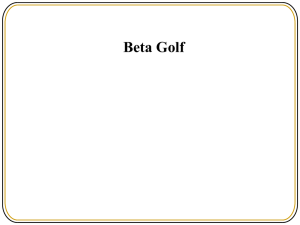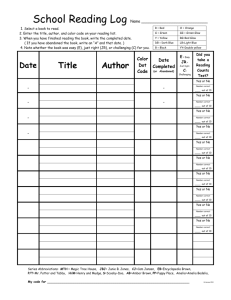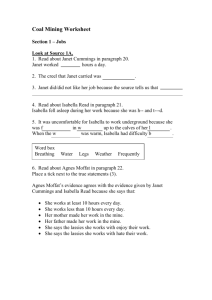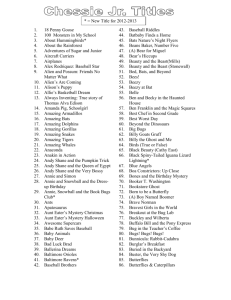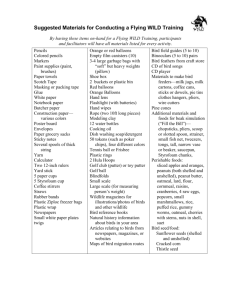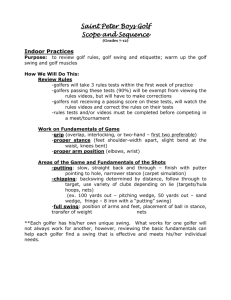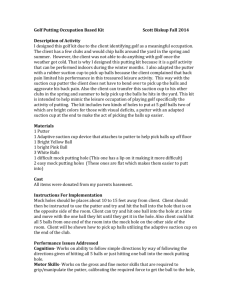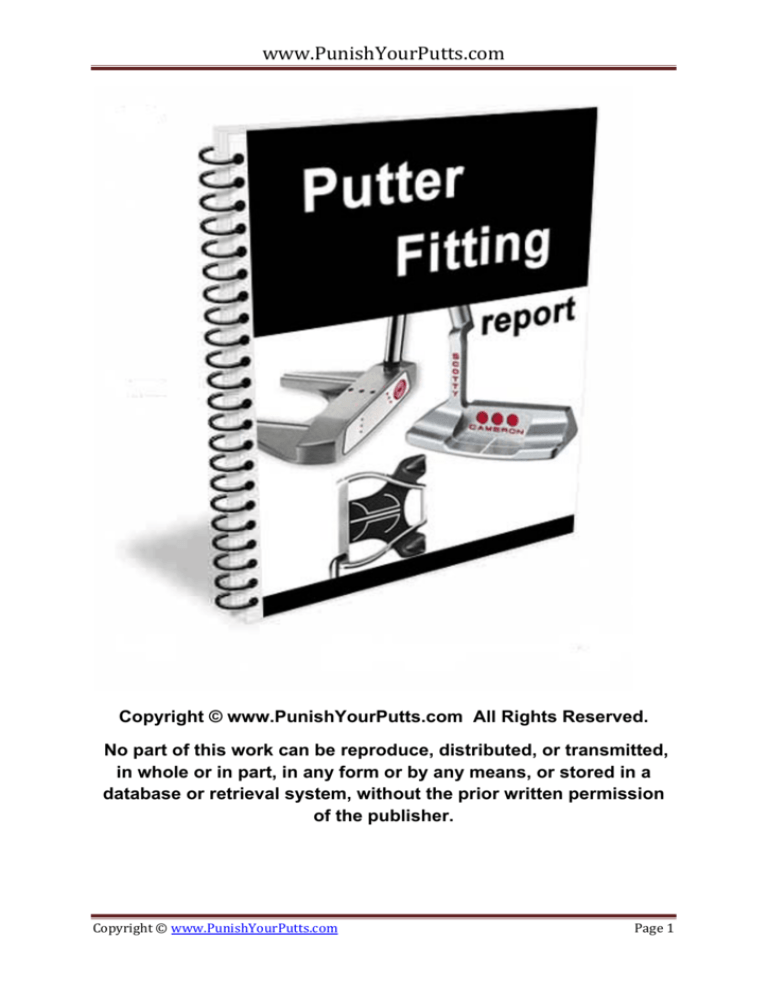
www.PunishYourPutts.com Copyright © www.PunishYourPutts.com All Rights Reserved.
No part of this work can be reproduce, distributed, or transmitted,
in whole or in part, in any form or by any means, or stored in a
database or retrieval system, without the prior written permission
of the publisher.
Page 1 Copyright © www.PunishYourPutts.com www.PunishYourPutts.com The Putter Fitting Report.
It is important to make sure your putter fits both your posture and your stroke. By having your putter adjusted to match your build you can certainly improve your putting stats not to mention your putting confidence. It doesn’t mean you will sink every putt on the course, but it will certainly increase your chances of sinking more putts. The biggest thing when talking about putter fitting is the lie angle and the length. The other factors include putter grip, putter head design, swing weight, and even the fact or loft will be discussed. The final part will focus on what you should do to pick up a good putter when you walk into a golf shop. It's funny, when you feel good with the putter, the rest of your game
starts clicking. Robert Allenby Page 2 Copyright © www.PunishYourPutts.com www.PunishYourPutts.com Lie angle and Length
Don't let a putter's length and lie and other features dictate your stroke. Instead, start with sound mechanics in the setup and stroke and get a putter that fits you and your stroke. Most people let their golf clubs, not just putters, dictate their swing and putting stroke. This often decreases the golfer’s natural abilities and puts them in a less stable and strong posture. Before we talk about the putter’s lie and length, we should discuss an ideal putting posture, so that we can fit the putter to your build. An ideal putting posture should be reasonably effortless, and helps you to feel centered and stable. At the same time, you should be able to turn your head and see the target line. Ideally, you would have minimal rounding in your back, as prolonged stance in that posture could lead to aches in the back muscles. However, we are all of different athletic abilities, and to have little rounding in the back is difficult to achieve, and requires flexibility in the hamstrings. Now, it is in my opinion after observing hundreds of golfers, that a standard 35 inch putter would fit perfectly for any golfer around 6 foot to 6 foot 4. Anyone who is 5 foot 5 inches to 6 foot, would do well with anything between a 34 to 35 inch putter. Anyone who is below 5 foot 5, could try out putters around 33 inches. This is just a guide, obviously if something doesn’t feel right to you, Page 3 Copyright © www.PunishYourPutts.com www.PunishYourPutts.com then you shouldn’t go ahead with it. And if you have a strong personal preference for a certain length, then you should stick to that. Having confidence is so important in putting. The best way to go is to try out different lengths, and see which putter puts you in the best posture (remember, you want to feel centered and balanced). You don’t need to practise your stroke at this point, because the weight of the putter may influence the feel and your choice of putter, and we will talk about putter head weight later in this report. Now when you picked a preferred length, let’s talk about the lie angle. The lie angle is the angle formed by the shaft and sole of the putter head when the putter is held in a neutral position at address. Ralph Maltby, a leading expert in golf equipment, says the lie angle: “The lie angle is a major factor in controlling the initial direction the ball will go after impact. If the toe of the putter is sticking up in the air, the ball will be pulled slightly to the left. Conversely, if the toe of the putter is down and the heel is up in the air, the ball will most likely be pushed slightly to the right.” Page 4 Copyright © www.PunishYourPutts.com www.PunishYourPutts.com Obviously this doesn’t happen in all cases. It is just a tendency. Maltby continues “An incorrect lie angle will also cause a slightly less solid hit because the ball is being impacted at more of a glancing blow which also adds some degree of side spin". Ideally when you decide on a putter length, you want to make sure you have the right lie angle for yourself. You want to putter to sit flush on the ground, and not sit it so that the toe or the heel is off the ground. The standard lie angle for most off‐the‐shelf putters is between 70 and 72 degrees. I find it that for most people, this lie angle sits too upright. This means most golfers would have to hold their hands up higher in order for the club to sit well on the ground. Putting expert Stan Utley also mentions that he finds many tour level golfers prefer a slightly flatter putter, somewhere in the range of 68 ‐ 70 degrees of lie angle. Personally, after using a putter with 69 degrees of lie angle, I find it so much better in terms of how it sits on the ground and how it feels in my hands. I feel that my hands and wrists are in a more natural position, rather than feeling like they have to be held high so that the putter can sit flat. Unfortunately, the lie angle is not something that can be easily altered. If the putter didn’t have a custom fitting option of a certain lie angle you wanted, the only other option is to bend it. It is best to see a club fitter to get your putter bent. It is only possible to bend the putters made of soft metals. This includes most Scotty Cameron putters, some PING putters, but not most Odyssey putters, or Taylormade putters. Cheaper putters are usually cast out of a hard alloy or steel, which makes it difficult to impossible to bend. Page 5 Copyright © www.PunishYourPutts.com www.PunishYourPutts.com Also bear in mind that the lie angle of a putter is difficult to alter when the shaft is inserted directly into the putter head without any hosel or shaft bend. Here are a few tables to summarise lie and length for you. Possible Putter Lengths Ideal Putter Lengths
5 foot to 5 foot 5 33 inches to 34 inches 5 foot 5 to 5 foot 8 33.5 inches to 34.5 inches 5 foot 8 to 6 foot 34 inches to 35 inches 6 foot to 6 foot 4 34.5 inches to 35 inches Above 6 foot 4 35 inches and above 5 foot to 5 foot 3 33 inches 5 foot 3 to 5 foot 6 33.5 inches 5 foot 6 to 5 foot 9 34 inches 5 foot 9 to 6 foot 34.5 inches 6 foot to 6 foot 4 35 inches 6 foot 4 to 6 foot 7 35.5 – 36 inches If the putter is too short If the putter is too long You will stand closer to the ball and your eyes will possibly be beyond the ball. The plane of your putter path will be more upright as your putter shaft will be more upright. The heel of your putter will tend to lift off the ground causing it to aim to the right. A putter that is too short for you will cause you to crouch over putting added pressure on your back. This is especially true if you have tight hamstrings. But having the putter too short, it will restrict the smoothness of your stroke. It can also cause you to straighten your arms into a locked position, which tightens your muscles and your stroke may become uneven and jaggered. You will stand further from the ball and your eyes will be well inside the ball. The plane of your putter path will be flatter and the toe of your putter will most likely be off the ground pushing your aim to the left. To accommodate the extra length you will have to cramp up your elbows to close to your body rather than let your arms hang naturally under your shoulders. Having arms bent close to your body may affect your stroke, especially on longer putts. This also increases your wrist cocking. Page 6 Copyright © www.PunishYourPutts.com www.PunishYourPutts.com If the toe of the putter sticks up
If the heel of the putter sticks up
You will need a flatter lie angle or else the ball will likely to be pulled to the left. You will need a more upright angle or else the ball will likely to be pushed to the right. Page 7 Copyright © www.PunishYourPutts.com www.PunishYourPutts.com Putter Grip
The grip is the only connection that your hands will have to your putter. You want to make sure your hands are comfortable on the grip. Conventional thinking equates thin grips with a wristy stroke with the shaft placed more so in your fingers. There is an emerging trend of fat grips on the market. Fatter grips put the shaft more in the lifelines of your hands, giving you a steadier hold on your putter as well as promoting an arm‐and‐shoulder pendulum stroke. They help to prevent your wrists from breaking down during your stroke. The one small disadvantage of an oversized fat grip on your putter is that it may not fit into putter tube on your golf bag. Off‐the‐shelf putters use a standard paddle rubber grip of about 11 inches with a flat front flange so that you can place both your thumbs on top of the shaft one under the other. If the grip has been properly fitted, the flat part should be 90 degrees to the putter face. Choosing a putter grip is largely dependent on how good it feels to you. So try different types, and work out for yourself which ones you prefer and which ones you do not like. Doesn’t matter what style of grip, you certainly want it to feel comfortable and gives you good control at the same time. Page 8 Copyright © www.PunishYourPutts.com www.PunishYourPutts.com Putter Head Design
It’s amazing how many putter head designs there are on the market. Yet most of the designs pursue 2 ideals. The first ideal is to give the putter head alignment lines so that the golfer is better able to visually line the ball up properly. Whether it’s the odyssey two‐ball putter, or something else, the idea is so that you can line the ball up down the target line. Secondly, the head shape gives different internal head weighting. The idea is that the if more of the weight of the head is distributed in the peripheries, then this makes the sweet spot bigger on the putter face and reduces the twisting effect of the club (MOI). Here’s a secret not many people know... The more weight of the putter head is distributed in both the heel and toe, the harder it is for you to push or pull the putt. This is because these putters massively increase MOI and the putter will not only twist less on an off‐center putt, but also twist less in your back stroke. However, the most important factor in choosing a putter is still... how the putter feels in your hands. There are different types of shaft inserts in putters. (Meaning where the shaft inserts onto the putter head) If the shaft inserts into the middle of the putter like the putter you see just above, then this is called a face balanced putter. What this means is that it’s more designed for the golfer with a straight back straight through stroke. If the shaft inserts into the heel of the putter, then it’s designed for a putting stroke that follows an arc around your body. It’s also called the swinging gate Page 9 Copyright © www.PunishYourPutts.com www.PunishYourPutts.com path. A typical example would be the kind of putter that Phil Mickelson uses, as seen below. There are putters that are in between the two shaft insert styles, such as the PING Anser putter seen on the right. This is designed in between the two extremes and suits most golfers. It is in my opinion that most golfers have a slight arc in their putting stroke and not dead straight back and through. That’s only natural, because of the way we’re naturally built. That’s why you see not as many center shafted putters on the market as the conventional heel shafted putters. Overall, I would keep these facts in mind when choosing a putter, but certainly wouldn’t let these things get in the way of finding a putter that feels good and sits well on the ground. Page 10 Copyright © www.PunishYourPutts.com www.PunishYourPutts.com Swing Weight and Head Weight.
I am very aware of the weight of the putter throughout the swing, and to
promote this feel I hold the club very softly at its end.
Bobby Locke It is common in the golf industry to describe the weight of the putter through the weight of the putter head for a given length. There is no standard head weight for a putter. It can be anything nowadays. The relationship between the length, the head weight, and the overall weight of the putter varies from manufacturer to manufacturer and by model. Companies like PING and Scotty Cameron uses the head weight such as 350 gram as a measure of the swing weight of the putter. Most mass‐produced putter heads are designed for a standard off‐
the‐shelf 35‐inch putter and weigh around 330 to 350 grams. In theory the head weight should change to keep the same relationship of head weight to grip weight when you either shorten or lengthen the putter. This is why you may notice many premium companies increase the head weight by 10 grams per inch shorter than standard 35 inches. For the technically minded the head weight is used to calculate the swing weight of the putter. Swing weight is the relationship between the weight of the grip end of the club and the head end and is measured on a 14‐inch fulcrum (balance) scale. It has an impact on your tempo and feel. Page 11 Copyright © www.PunishYourPutts.com www.PunishYourPutts.com Most putters are between C8 to D8 swing weight on the 14 inch fulcrum scale. Now, here’s where all of this comes into practice. Nobody has ever complained about a putter being too heavy, only that the putter feels too light. Studies show that having a putter with a slightly heavier swing weight, increase the feel of that putter and because of that added momentum in the putter head, the putting stroke also becomes smoother. This is the reason why some golfers with the yips go to a broomstick putter or a belly putter. These putters are much longer than the traditional putters, and they have an extremely heavy swing weight. If you ever get a chance to hold one, just notice how smoothly the putter head goes back and forth, using its own momentum to guide the way. There is a school of thought that you should use a heavy putter to putt on slow greens and a light putter to putt on fast greens. However I disagree with this theory. Many old putters before 2005 were very light compared to the putters made today. Many cheaper bulk produced putters are lighter than the more premium brands. Also if you were to cut your putter down, then it becomes lighter on the swing weight scale. Here’s how you can make your putter heavier. There are a few ways, but the easiest one is to get some lead tape and stick them to your putter head. Page 12 Copyright © www.PunishYourPutts.com www.PunishYourPutts.com You can usually buy these at golf shops, and also in tennis stores. The best places to put these leap tapes are either on the bottom of the putter, (the sole) or the back of the putter. The benefits of putting them on the sole is 1) You don’t see them when you putt, 2) They won’t catch on the grass, 3) They usually fit a lot better on the sole than on the back of the putter. Put one piece of lead tape on at a time and feel for change in the weight of the putter. Here’s something most people don’t know. Put the lead tape on both the toe and heel of the putter head. This increases the MOI (Moment of Inertia) which means the putter will twist less upon impact. This also increases the size of the sweet spot on the putter face. If lead tape is not something you want to do, you could alternatively put sand or lead powder into the shaft of the putter. However this isn’t as effective as the lead tape strategy. Overall, a heavier putter seems to work better than a lighter putter. If the putter head is too light, you could find yourself flicking at the ball with too quick a tempo. A putter with more head weight will promote a slower and more consistent tempo. Page 13 Copyright © www.PunishYourPutts.com www.PunishYourPutts.com Putter Loft
The loft of a putter is the angle formed by the putter face and a level surface when the putter is held in a neutral position at address. It is measured in degrees. This is the reason why there is loft on your putter, and it’s not just a straight face. You need some loft to lift your ball out of the shallow depression caused by the ball’s own weight and on to the top of the grass for a truer roll. The rougher the green, and the softer it is, the more loft is preferred to get the ball rolling faster. The harder, faster and slicker the greens are, the less important the loft is. Most putters are made with a loft of either 3 or 4 degrees. Studies have shown, that the optimal loft on the putter at impact is 4 degrees. This means, ideally using a putter with 4 degrees of loft, you want to keep the shaft vertical at impact. Too much loft can jeopardise distance and directional control as the ball will tend to bounce after impact. With too little loft you will compress the ball into the turf and it will also skid towards the hole. Since changing the loft of the putter is not an easy thing to do at all, most of the time I recommend golfers to leave that component of their putter. The only time in which a change in loft is recommended, is when the golfer habitually putts with an exaggerated forward press or a backward lean of the putter. When you apply a forward press, this effectively reduces the loft on the putter face. So ideally, you want to create more loft on the putter to compensate for this action. If you have a backward lean of the putter, which means your hands are behind the ball at impact, then you will need less loft of the putter. This also is affected by your ball position and hand position. Page 14 Copyright © www.PunishYourPutts.com www.PunishYourPutts.com Best thing to do here is to consult club fitters and other golf professionals whether they have a putter fitting machine or are happy to alter the loft for you. Chances are, it will be much easier for you if you left this to the default loft. Instead, you could focus on keeping the shaft of the putter vertical at impact, to optimise how the ball takes off the putter face. Page 15 Copyright © www.PunishYourPutts.com www.PunishYourPutts.com Going to a golf shop.
It will be disappointing to go to a golf shop knowing everything that is included in this report. What you will find is that most putters (90%) are at 35 inches, lie angle at 71 degrees and there aren’t that many choices in specification. What you can do is try out different models and find a few putters that feel the best to you. Then you want to eliminate them one by one through a few quick tests. Test 1, how well does the putter line up for a 3 foot putt? If a putter doesn’t line up well on a 3 foot putt, drop it immediately. You won’t gain any confidence with it, it will just get frustrating later on. Test 2, how well does the putter line up for a 6 foot putt? These putts are important, you want to pick out the putters which line up to the target the best. Test 3, how does it sit on the ground? You want a putter that does not wobble on the ground. You want something that enhances your confidence at address. When you finally find the model you want, it would be a good idea to ask the shop assistants whether any modifications can be made to it. Of course it is entirely your choice whether you want to modify your putter or not, using Page 16 Copyright © www.PunishYourPutts.com www.PunishYourPutts.com the guidelines set in this report, I hope you find that putter that makes you feel confident, relaxed and certain of your choice. -Featured Article-
How to Choose a Putter in a Golf Shop?
This article aims at giving you advice on how to pick a good putter in a golf shop.
When you walk into a golf shop, there are usually heaps and heaps of different putters, just
waiting for you to pick them off the shelf. These are the things you want to know about
putters.
Most (I mean 95%) of all putters come at the standard 35 inches, with lie angle around 71
degrees. From experience, this size would fit someone who is 6 foot 1 to 6 foot 4 perfectly.
For all us shorter golfers, 35 will most likely be too long, and what tends to happen is the toe
of the putter sticks up from the ground when you sit it down.
I am 5 foot 10 and I have a putter that is 34 and a quarter inches. I have the lie bent from 71
to around 68 degrees.
Unfortunately there isn’t much we can do about the fact that most putters come at 35 inches.
There are a few models which you may find that comes at 34 inches, so definitely have a feel
of them and see if you like them any better.
The other option is to get your new putter cut down, but the downside to that is the fact that
the putter will feel a lot lighter. The swing weight would be changed. To re-adjust the swing
weight of the putter, you can add lead tape to the back or bottom of the putter.
On the topic of weights, not all putters weigh the same. You’ll notice, as a general rule, that
more expensive putters seem to weigh more. Now personally I have never encountered
anyone to complain that their putter is too heavy, they only ever think the putter is too light!
The reason being, a light putter makes you feel like you can’t control the club as well as
something that is heavier. A heavier putter usually works much better especially when the
Page 17 Copyright © www.PunishYourPutts.com www.PunishYourPutts.com golfer isn’t too confident over putts.
But a good fix for a light putter is just to get some cheap lead tape and attach it to the bottom
of the putter.
Now, how much does should you spend on a putter?
Well, there’s huge differences between a cheap $30 putter compared to a premium putter
(Scotty Cameron, Odyssey etc). Not only do the premium putters feel better, sit better on the
ground, they also have better alignment systems (ie, very straight clear cut lines).
I would suggest that you have in mind a budget before purchasing a putter.
Overall, you want a putter that feels good to you, sits well on the ground and also allows you
to line up to the hole properly. If you can find a putter that satisfies all 3 criteria, then you
have a suitable putter for yourself.
Make sure you take the time to practice some putts in the shop if possible. The most
important thing is to focus on how the putter feels to you and also practice a lot of short putts.
Why? Because short putts are your bread and butter shots and you want to be 100% confident
with them!
www.PunishYourPutts.com Nothing Feels As Good As Sinking Putts
Peter Pell (Your Putting Coach) www.PunishYourPutts.com Page 18 Copyright © www.PunishYourPutts.com

